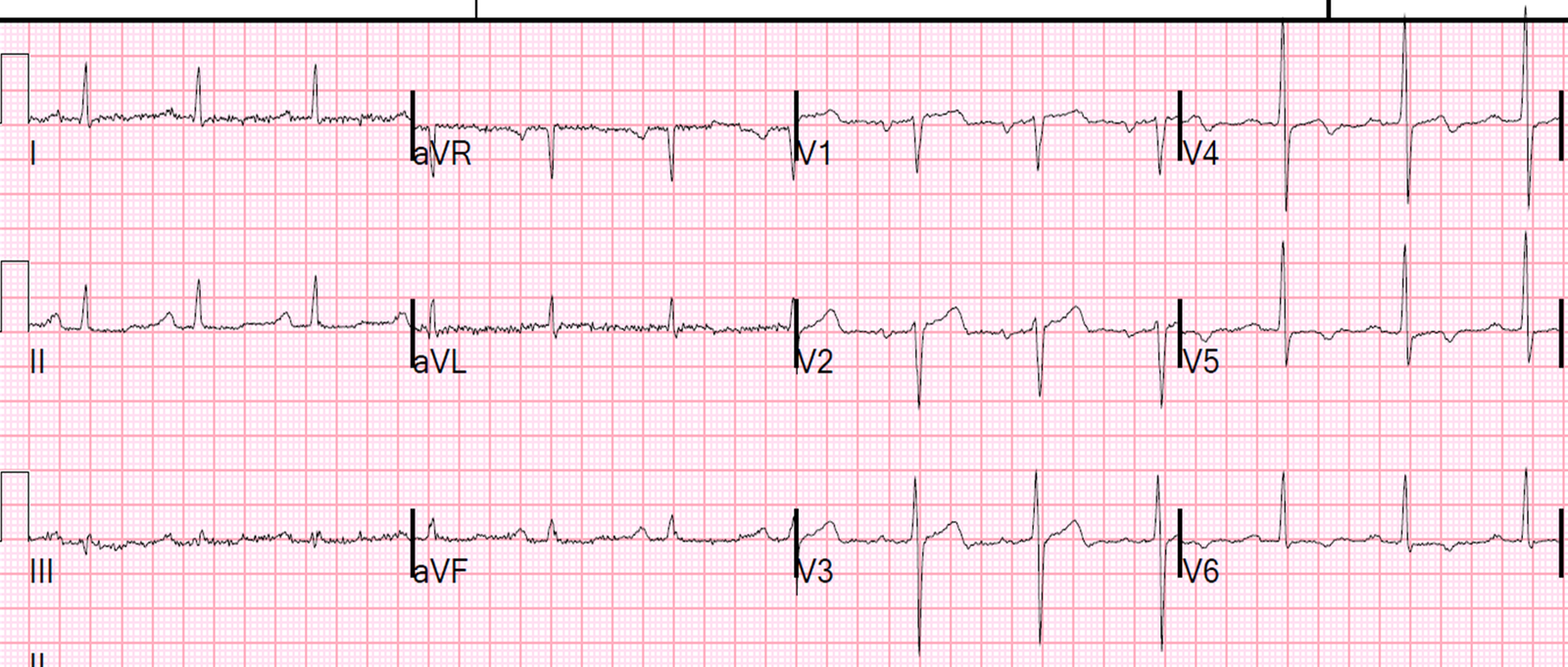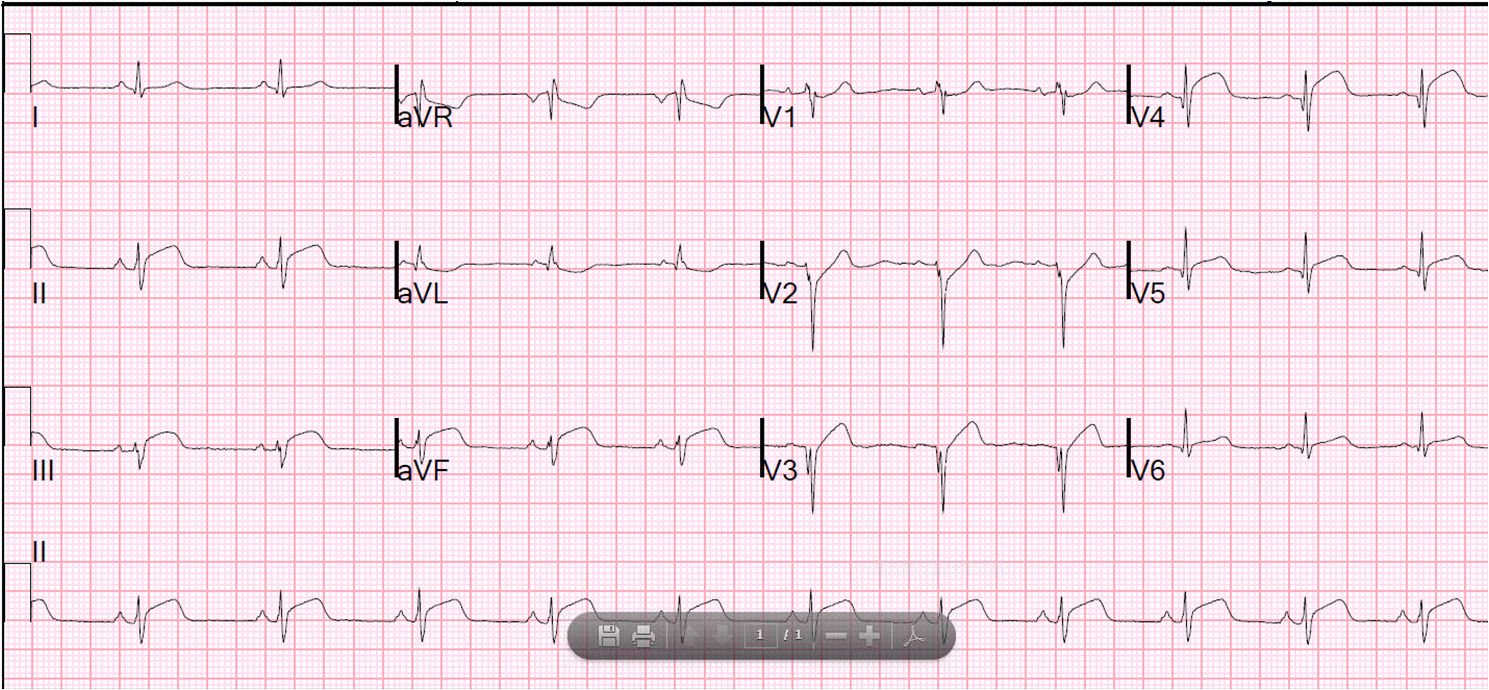A 56 year old diabetic male with
family history of young MI and prior CAD with stent was awoken by typical
substernal chest pain. He had this ECG recorded.
Here are precordial leads enlarged:
Strictly speaking, the formula
should not be used because there is terminal QRS distortion, which by itself
makes STEMI almost certain: “Emergence of the J point ≥50% of the R wave
in leads with qR configuration, or disappearance of the S wave in leads
with an Rs configuration)”
They gave him nitro and morphine and
his pain resolved. The ED ECG is below, 27 minutes after the prehospital ECG, and few minutes after resolution of pain.
 |
||
| Pretty much normal |
The ED physician activated the cath
lab and the cardiologists were in disagreement but took the patient to the cath
lab.
He had a 95% thrombotic LAD that was
stented. Troponin I peaked at 2.4 ng/ml.
Here is his 30 hour ECG:
 |
| Sinus with PVC. Classic Wellens’ syndrome ECG |
These things are clear:
1. During the prehospital ECG, the
LAD was occluded, or flow was limited to the point where there was ST elevation
(injury due to subepicardial, transmural, ischemia)
2. The pain resolved (a key
criterion for Wellens’)
3. The repeat ECG was normal
4. The artery had clearly reperfused
and had adequate flow to the anterior wall (another key criterion for Wellens’)
5. The patient needed an angiogram
and PCI at some point
6. The next day ECG was identical to
Wellens’ ECG
This is a great demonstration of
something I have promoted for years, but without proof:
That Wellens’ syncdrome is the
result of the aftermath of spontaneously reperfused LAD occlusion that went
unrecorded during the episode of pain.
This idea is supported by these
characteristics of Wellens’ syndrome:
1. Wellens’ syndrome is always after
resolution of pain
2. There are always preserved
R-waves
3. The LAD is always open, or there
is good colllateral flow
4. The T-wave inversion of Wellens’
is identical to the pattern of T-wave inversion that occurs after therapeutic
reperfusion of LAD occlusion.
See this study by
Doevendans et al.
See this study by
Wehrens et al.
5. Cases like this
Emergent Cath Lab Activation
Questions
1. Should the cath lab be emergently
activated for Transient ST Elevation?
2. Should it be activated emergently
for Wellens’ syndrome?
I don’t think there is any
evidence-based answer to these questions. I would argue that Wellens
syndrome is a result of transient ST elevation that was not recorded.
However, the artery is open. Both conditions are very high risk for
re-occlusion.
The standard answer for someone who
had that ST elevation recorded (Question 1), as in this
case, is to go to the cath lab. Here is what can happens if you make the mistake I did and
do not activate the cath lab.
The standard answer for Question
2 would be “No”, but I would argue strongly that it is very high
risk and it requires maximum antiplatelet and antithrombotic therapy and continuous
12-lead ST segment monitoring. One cannot depend on symptoms to guide
the recording of subsequent ECGs, and I will show an example of this in the
next post.






Great case Dr. Smith…
I have a few questions:
Regarding the "standard answer" for question 2 being no… If wellens means the artery was previously occluded and reperfused, who is to say it could or would not re-occlude at any second? Because of the implication of at least transient occlusion, I do not understand the "lack of urgency" of the standard answer.
Regarding the obliteration of the S wave in STEMI.. Is there any other entity to your knowledge that also obliterate the S wave? Or is the reason that terminal QRS distortion virtually assures STEMI because mimics preserve the S wave?
Lastly, I've often seen in wellens' a "return" of the obliterated S wave in addition to the T wave inversion. Is this a feature of Wellens, or is it not consistent in your view?
Thank you as always!
Dave B
Dear Dr. Smith, thank you very much for these really informative cases, from which I learn a lot.
I agree wholeheartedly with your statement regarding development of a Wellens pattern. Yes, I did see several patients in whom a full Wellens pattern emerged just after succesful stenting of their LAD lesions.
Still, I am not able to explain the near-normal pattern in the interim ECG, ie, the one before the Wellens one.
Mehmet.
Dave,
1. I don't know that it is widespread knowledge, partly because I don't have definitive proof) that Wellens' is the aftermath of occlusion. Furthermore, the artery is open, and as long as you are treating with maximal medical therapy and monitoring for reocclusion with continuous ST segment monitoring, then you're probably ok to wait until daytime hours to do the cath.
2. I don't know of anything else that obliterates the S-wave. It is not well studied so is not completely understood.
3. If a STEMI with Terminal QRS distortion has early reperfusion, I would expect that S-wave to reconstitute. Again, little solid data on this.
Thanks for the great questions.
Steve
First, Wellens' pattern occurs in about 60% of reperfusion cases in the studies I mentioned. It is not universal. This may be partly due to the timing of the ECGs in these studies. There may always or often be an intermediate stage of simple ST resolution. We know that ST resolution alone is a common finding of reperfusion. But ECGs are not recorded at 5 minute intervals on everyone! In order to know what happens, and it may be very different in different case, there would need to be continuous serial ECGs.
Steve Smith